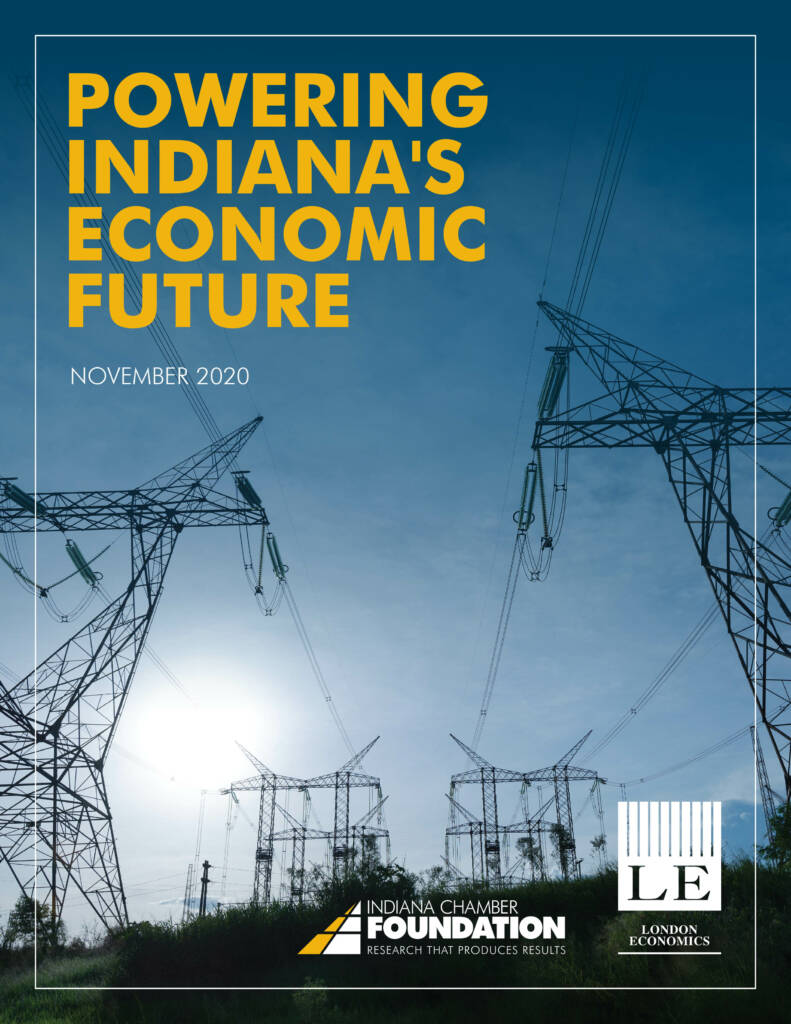(INDIANAPOLIS) — Five potential scenarios for the evolution of Indiana’s crucial electricity sector and a series of principles and recommendations for the state to follow are featured in a new Indiana Chamber of Commerce Foundation study.
Powering Indiana’s Economic Future is a comprehensive look at energy usage and related issues past, present and future. It was produced by London Economics International (LEI), a global firm specializing in energy and infrastructure analysis.
“Development of a thorough energy plan for Indiana is long overdue,” states Indiana Chamber President and CEO Kevin Brinegar. “This study provides the details necessary to guide the state’s work in this area – to best position Hoosier companies and citizens to enjoy affordable and reliable electricity.”
 Growth is projected for distributed energy resources (DERs), which are generation and storage that provide capacity close to the source (rooftop solar, wind, battery storage and more). A DER-centric pathway is one of the five scenarios outlined – with enhanced status quo, baseload preservation, aggressive decarbonization and competitive wholesale market being the others.
Growth is projected for distributed energy resources (DERs), which are generation and storage that provide capacity close to the source (rooftop solar, wind, battery storage and more). A DER-centric pathway is one of the five scenarios outlined – with enhanced status quo, baseload preservation, aggressive decarbonization and competitive wholesale market being the others.
The study finds that Indiana’s average electricity rates (2.9% increase per year from 2010-2019) are growing more rapidly than the national average, affordability is declining and reliability is lower than national norms. Reasons cited are flattening demand, replacing and maintaining aging infrastructure and necessary investments to comply with federal environmental regulations.
Despite a decline in Midwest and national cost rankings, the study notes the “percentage difference between prices in Indiana and the top-ranking state in both years has not changed significantly.” It adds that the “change in relative status may be partly a matter of timing. Going forward, it is reasonable to assume that … rates in some states may begin to rise at a rate faster than Indiana’s (where significant investments and upgrades have already been made).”
Ron Christian, co-chair of the broad-based advisory council for the study and longtime leader with Evansville-based Vectren, now a CenterPoint Energy Company, offers that “incredible and fast-paced change is occurring within the energy industry The development of new technologies and evolving customer preferences for ‘cleaner’ energy are on a collision course with our longstanding, reliable homegrown energy in the state.
“This study presents a balanced perspective on these competing interests and provides a valuable framework on how best to navigate this changing environment.”
LEI forecasts lower electricity price growth over the next decade than what was experienced in the past 10 years. Additional environmental regulations, expansion of energy efficiency efforts and the potential for DER emergence are factors placing upward pressure on prices. Downward impacts include low natural gas prices and the declining costs of renewables.
“Indiana is the most manufacturing intensive state in America, so it is imperative that we maintain a competitive business environment that allows our manufacturing sector to create new jobs and add investment,” adds Tom Easterday, study advisory council co-chair and former executive with Subaru of Indiana Automotive. “Addressing how we power Indiana’s future is an important step toward ensuring affordable and reliable energy for Indiana that can help keep our state competitive.”
Electricity generated by coal decreased from 93% in 2009 to 59% in 2019. The study finds that an additional 7.7 gigawatts of coal is expected to be retired by 2028. Growth is projected to continue in the areas of natural gas, solar and wind generation. Indiana generated 6% of electricity from renewables in 2019; while further capacity remains, researchers offer the reminder of the limitations of intermittent sources of power.
LEI also looks at Indiana’s overall industry and government regulatory structures, regional comparisons and analysis, and additional issues that impact ratepayers. It notes the significant implications and uncertainty of COVID-19 on demand and planning processes.
Strengths and advantages for Indiana, according to the study, include its location (crossroads of networks), overall resource potential, strong in-state analytical capabilities and flexibility as a result of its high proportion of industrial usage.
Going forward, it is strongly recommended that “legislation should avoid being too prescriptive and should instead delegate responsibility for enforcement to regulatory bodies wherever possible.” A list of key principles also includes, in part:
- Maintaining a technology and ownership neutral approach
- Acknowledging that DERs will provide a form of competition regardless of whether the market is unbundled
- Relying on lessons learned from other jurisdictions
- Avoiding any sudden policy movements
“Indiana continues to be one of the top business climates in the Midwest and one of the best in the nation,” Brinegar adds. “How our state plans for its energy needs and establishes a reliable, cost-effective and evolving energy system is critical to our state’s economy.
The Indiana Chamber initiated the study to identify key issues, gather data and project future scenarios in order to help policymakers grapple with this critical topic.
The energy overview continues the work of the Indiana Chamber Foundation in providing practical public policy research on key areas of interest to Hoosier businesses and consumers. This project is made possible through the support of the following sponsors:
- Champion: Duke Energy
- Gold: Vectren, A Centerpoint Energy Company; Indiana Michigan Power
- Silver: Alliance Resource Partners; ArcelorMittal; CountryMark; Fort Wayne Metals; Haynes International; Indiana American Water; Indiana Electric Cooperatives; Indiana Energy Association; INDIEC (Indiana Industrial Energy Consumers); Metal Technologies; NIPSCO; Subaru of Indiana Automotive; Sunrise Coal; Walmart Inc.
- Bronze: Alcoa Corporation; EDP Renewables; MISO
- Contributing: Beck’s Hybrids; Plymouth Foundry
The full study and executive summary are available at www.indianachamber.com/studies.
###
The Indiana Chamber partners with 25,000 members and investors – representing over four million Hoosiers – to achieve the mission of “cultivating a world-class environment which provides economic opportunity and prosperity.”

